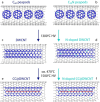Nitrogen Doping of Confined Carbyne
- PMID: 40354578
- PMCID: PMC12105017
- DOI: 10.1021/acs.jpclett.5c01063
Nitrogen Doping of Confined Carbyne
Abstract
Low-dimensional carbon allotropes belong to the most revolutionary materials of the most recent decades. Confined carbyne, a linear chain of sp1-hybridized carbon encapsulated inside a small-diameter carbon nanotube host, is one extraordinary nanoengineering example. Inspired by these hybrid structures, we demonstrate the feasibility to synthesize nitrogen-doped confined carbyne by using azafullerenes (C59N) encapsulated in nanotubes ("peapods") as precursors for the growth of confined carbyne. Resonance Raman spectroscopy as a site selective local probe has served to identify the changes in the spectra of nitrogen-doped versus pristine carbon peapods and confined carbyne. We are able to disentangle frequency changes due to charge transfer from changes due to the difference in mass for both the nanotube and the carbyne, where different effects dominate. This study demonstrates a suitable pathway to achieve controlled doping of carbyne chains via the use of specifically doped precursors.
Figures




References
-
- Fazio E., Neri F., Patanè S., D’urso L., Compagnini G.. Optical limiting effects in linear carbon chains. Carbon. 2011;49:306–310. doi: 10.1016/j.carbon.2010.09.026. - DOI
-
- Wang Y., Huang Y., Yang B., Liu R.. Structural and electronic properties of carbon nanowires made of linear carbon chains enclosed inside zigzag carbon nanotubes. Carbon. 2006;44:456–462. doi: 10.1016/j.carbon.2005.08.026. - DOI
LinkOut - more resources
Full Text Sources

